The term "tantric" is often associated with erotic iconography and sacred sexual practices, although the latter idea is greatly exaggerated in most cases.
However, one can say that there was a definite surge in erotic art and a more open attitude toward sex during the Tantric period. Not that India was any stranger to such ideas since the Kamasutra was written in this region, but it has been suggested that more conservative attitudes had prevailed especially after the Muslim invasions.
Tantric texts give evidence of more open attitudes toward sacred sexuality flowing into India from the East -- from Suvarnadvipa, Mahacina and Cina, i.e., from Insular and Mainland Southeast Asia and South China.
Earlier I suggested that Tantric influences had been brought by the Sayabiga and Zutt into Islam via "dervish" groups, and that these influences also reached into Europe and were found in the Grail literature. During the height of the Tantric period, at the same general period when erotic temples like Khajuraho and Konark were being built in India, there arose a tradition of erotic sculpture in Romanesque art as well.

Source: http://goeurope.about.com/cs/sex/a/sexual_carvings.htm
From the Romanesque section (~12th century) of the Santa María Church-Fortress in Ujué, Spain. Compare above to this graphic sculpture from the 15th century Candi Sukuh Temple in Java.
Erotic elements in Romanesque art appear concentrated most heavily in northern Spain and southwestern France -- locations closely associated with the Agote peoples discussed in the previous blog posting. The style also became popular in Italy, England and Ireland. Note that these sexual carvings were displayed both in the interior and on the exterior of churches. Nothing comparable was found before, and starting in the Renaissance, the church began to suppress such artistic expression. Types of sexual and amorous literature that arose at about the same time was publicly burnt in some places. The evidence suggests then that the erotic displays in Romanesque churches were an intrusive development.
Anthony Weir and James Jerman in Images of Lust: sexual carvings on medieval churches suggest that the practice actually was diffused along the routes that led to Santiago de Compostela in Spain, where the great medieval pilgrimage took place to the supposed burial place of the Apostle St. James.
Motifs we have studied, like the Avaritia and la femme aux serpents, are to be found along, or in the close vicinity of, the four main pilgrimage roads of France, but only the westernmost, from Compostela, along the northern provinces of Spain, into Aquitaine, Poitou, the Vendee, Brittany and Normandy (with a tributary northeast of Paris to Liesse), thence to the British Isles, has sexual exhibitionists in significant numbers.
The exhibitionist sculpture included scenes of copulating couples, a depiction in Indian art known as mithuna. In the tantric art of Tibetan Buddhism, deities are often shown in a divine and sexual embrace known as yab-yum. In many cases, the couples in Romanesque churches are in non-missionary, Kamasutra-like positions as in the relief from Carennac, France below.
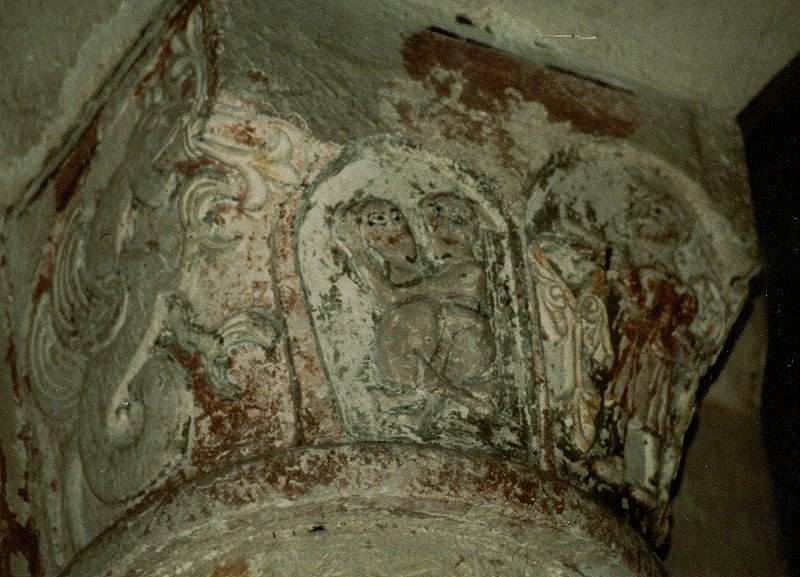
For some more clear examples of Romanesque mithuna, see this Beyond the Pale webpage or browse through the whole site.
Squatting figure motif
One important type of sexual exhibitionist motif displayed in Romanesque art is that of the squatting figure. Here is an example from Poitiers in France, and further below from Moulton in Suffolk, England:
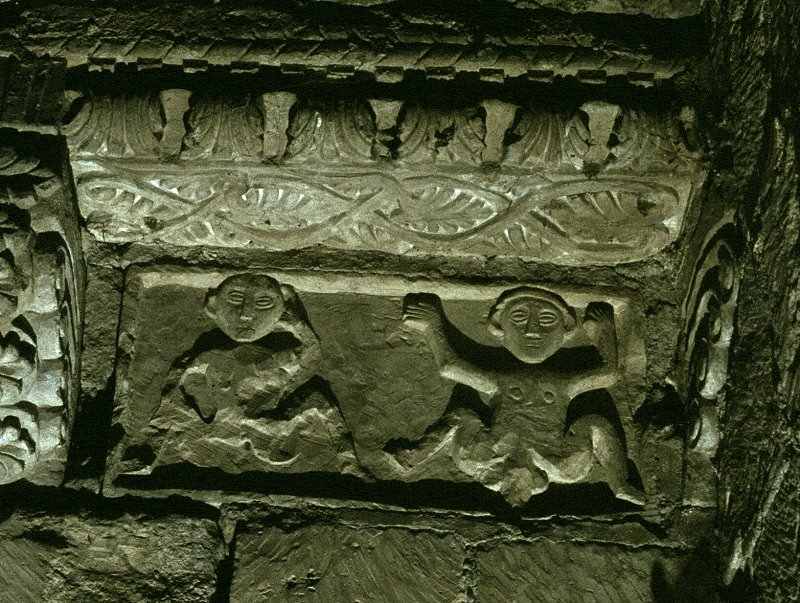
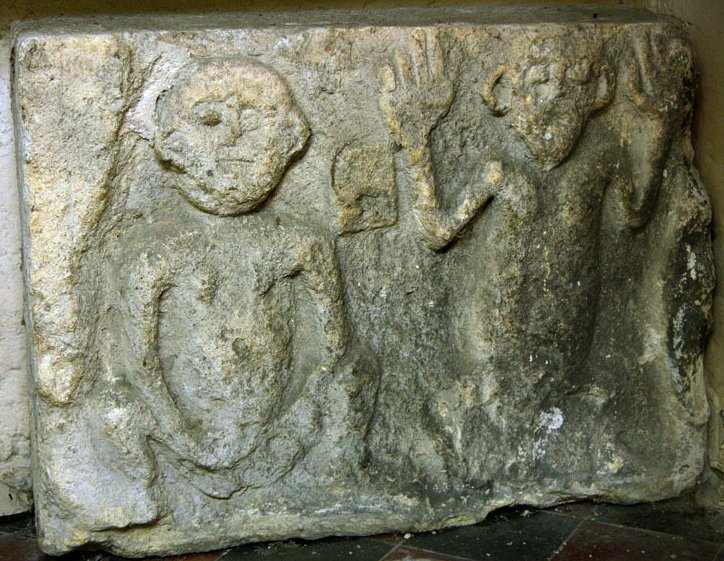
For more examples of this motif along with one for comparison from Candi Sukuh in Java, see the Poitiers page at the Beyond the Pale site.
Another type of squatting figure commonly found at Romanesque sites is that known as Sheela na gig and features a female figure boldly displaying her her vulva.
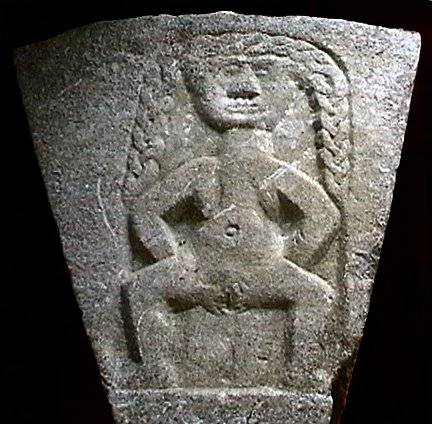
Sheela na gig from Rahara, Ireland (Source: beyond-the-pale.org.uk)
The squatting figure motif is a well-known and widespread element in the art of Southeast Asia and the Pacific. Robyn J. Maxwell, in her work on Southeast Asian textiles, states:
The oldest realistic representation of the human body on textiles presents a full frontal view, standing or squatting. Strength is conveyed in the stance, usually with feet apart and arms raised, although the bold 'hands-on-hips' pose is also an ancient representation.
The motif can be classified into three basic types:
- A high squat or standing figure with hands raised, usually above the head. Variations include hands on or near the hips or the elbows extended outward with hands dropping down. This figure gives an imposing look that may be protective against evil (apotropaic).
- A very low squat with groin at about the same level as hips. In many cases, this is a birthing posture. Tiwari notes that this is the traditional posture for parturition from South Asia to the Pacific where the squatting figure motif is still widely used to this day. The low, splayed squat is also found in male depictions, so it does not always represent child birth. Arms may be raised or positioned near the hips or groin. Here is an article on the Lajja Gauri statue that was popular in India during a period that overlapped with the Romanesque.
- A position of sitting on one's haunches as is common in many parts of Southeast Asia and the Pacific, or simply sitting with one's legs bent in front of the body as when squatting. This is often called the hocker motif. The elbows or hands are usually resting on the knees. When depicted with genitals, this figure often represents an ancestor. Check out this article on the hocker motif in Micronesia.
Not only is the squatting figure widely used in this region today, but it is also very old. Examples have been found among the Angono Petroglyphs in the Philippines and in the Harappan Culture of South Asia. Both Ban Chiang artifacts from Thailand and Dongsonian pieces display the squatting figure motif.
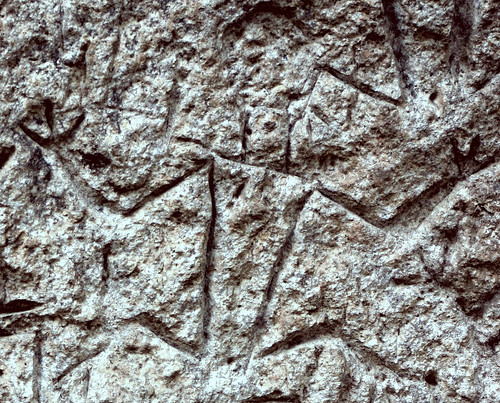
Squatting figure motif from the Angono Petroglyphs in the Philippines dated by cultural association to 2000 - 4000 BCE. The open end at the legs probably indicates a female figure. (Source: http://www.flickr.com/photos/40493841@N00/154225235/)
Meaning of motifs
Weir and Jerman suggested that the sexual exhibitionist art was meant as a lesson against sexual immorality. They note the presence of other motifs symbolizing greed and that in some cases these motifs include depictions of punishment or hellish surroundings.
Other alternative explanations that have been offered including suggestions that the motifs were fertility symbols; apotropaic, or protective against evil; or that they were meant for humor and to break down social inhibitions.
The squatting figure motif in the region of South Asia, Southeast Asia and the Pacific has attested functions for warding off evil; promoting fertility; sorcery; good luck; success during hunting, fishing, maritime travel and similar expeditions; and ancestor worship. A Harappan depiction shows a "goddess" in wide splayed squat sprouting a plant from her womb, and it has been suggested that this is the origin of the Lajja Gauri statues, which have a lotus instead in place of the head. T'boli textiles, according to Maxwell, may show the squatting figures giving birth to smaller figures of the same form again indicating a fertility or creation theme.
Romanesque changes in attitudes toward women
One thing to note during this period is the appearance in literature of new attitudes that uplifted the status of women. For example, the theme of "courtly love" appears to arise out of Mozarabic poetic romances in Moorish Spain and the works of Ibn Hazm (11th century) and Ibn Arabi (1165-1240).
The impulses come from the direction of Spain and it is hard to disconnect these changes from the sudden appearance of the very strange trend in sexual church art. The timing overlaps with the rise of Tantrism in South and Southeast Asia where we see similar types of art, but maybe with different interpretation.
Check out this page for a good representation of sexual exhibitionist art from the Romanesque period. And here for more on Tantric influences in the Grail Legends.
Regards,
Paul Kekai Manansala
Sacramento
References
Lommel, Andreas. Prehistoric and Primitive Man. London: Paul Hamlyn, 1966. 103.
Macdermott, Mercia. Explore Green Men. Loughborough: Heart of Albion Press, 2003.
Maxwell, Robyn. Textiles of Southeast Asia: Tradition, Trade and Transformation. Singapore: Periplus, 2003, 82, 83, 128.
O'Donoghue, Bernard. The Courtly Love Tradition. Manchester: Manchester University Press, 1982, 75-5.
Tiwari, Jagdish Narain. Goddess Cults in Ancient India: With Special Reference to the First Seven Centuries A.D. Delhi: Sundeep Prakashan, 1985, 210, 217.
Weir, Anthony, and James Jerman. Images of Lust: Sexual Carvings on Medieval Churches. London: Routledge, 1999, 144.







0 comments:
Post a Comment